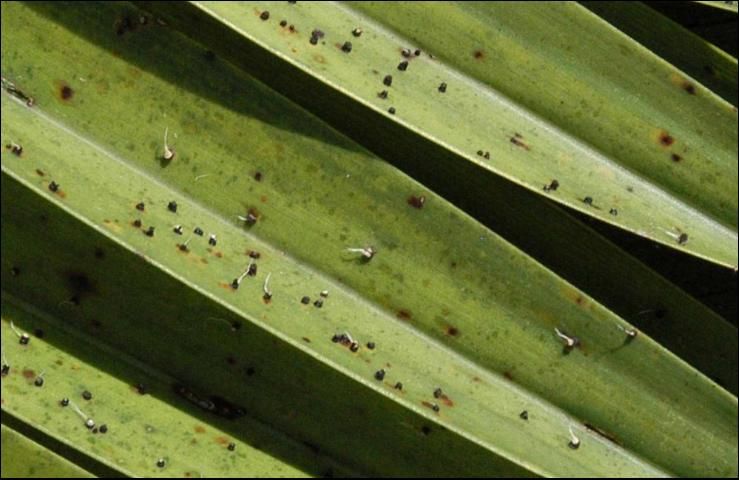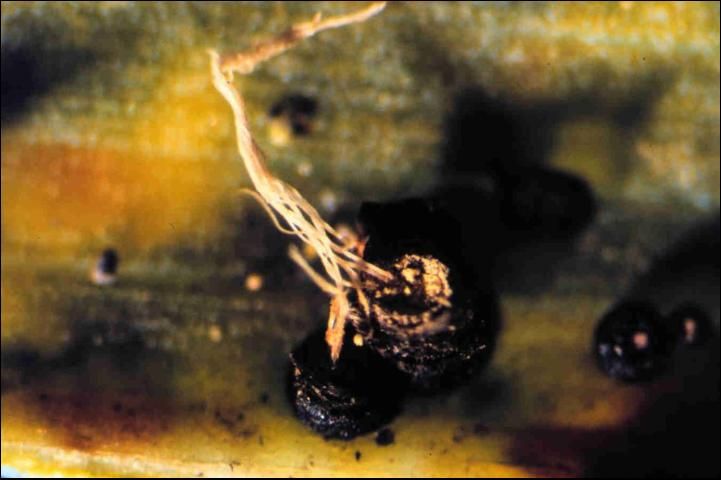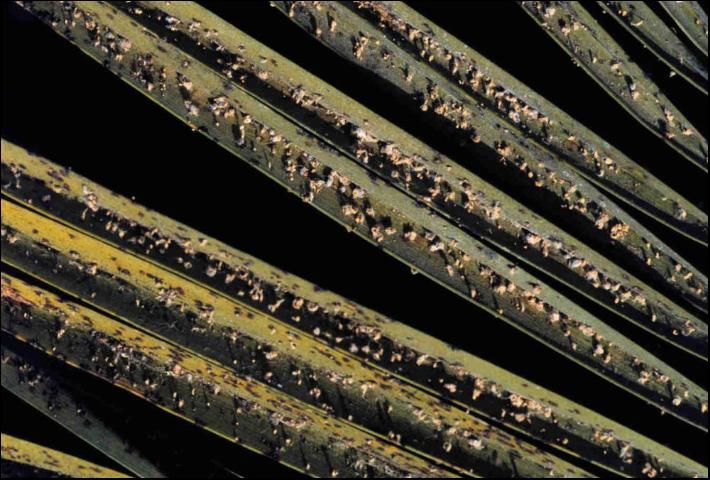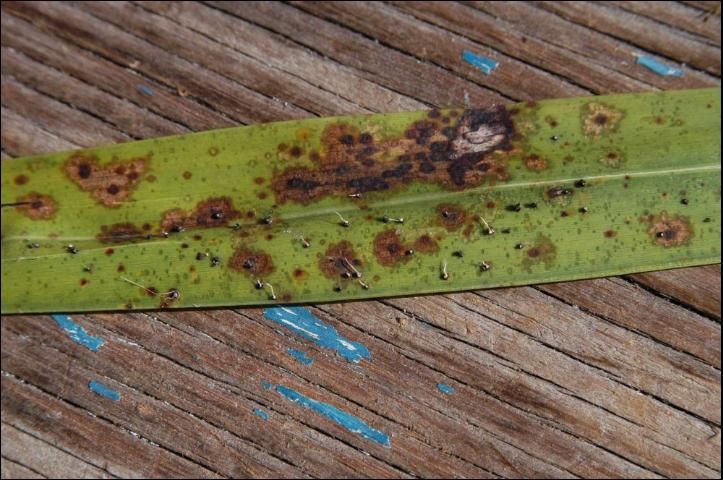Summary
-
Graphiola leaf spot is a fungal leaf disease caused by Graphiola phoenicis. The disease is often referred to as "false smut."
-
The primary hosts in Florida are Phoenix species, especially Phoenix canariensis (Canary Island date palm) and Phoenix dactylifera (date palm).
-
The disease is easily diagnosed by direct examination of the affected leaf tissue. Very small (1/16 inch), black, cup-shaped fungal bodies (sori) are present on the leaf blade of the oldest leaves (lowest leaves in the canopy). They can be easily observed without any magnification.
-
The disease is primarily cosmetic, and does not adversely affect plant growth in the landscape. Confusion regarding the seriousness of the problem occurs because most Phoenix palms grown in Florida suffer from nutrient deficiencies, which are far more debilitating than this disease.
-
Remove diseased leaves only if the palm is not exhibiting nutrient deficiency symptoms. Removal of nutrient deficient leaves will only make the nutrient deficiency worse, which will adversely affect palm health.
-
Fungicides may be useful for managing this disease, but research is limited as to products to use and timing of applications.
Introduction
Graphiola leaf spot, also referred to as "false smut," is a foliar pathogen of certain palm species. In Florida, it is primarily a cosmetic disease and does not adversely affect plant growth. Nutrient deficiencies, such as potassium or magnesium deficiency, are much more serious palm health problems than this disease, especially for Phoenix species.
Pathogen and Hosts
This disease is caused by the fungal pathogen Graphiola phoenicis. It is a unique fungus, both in appearance and life cycle, but it is widely distributed throughout the date palm-growing world. While numerous palm species have been identified as hosts of this fungus, the disease is most prevalent in Florida on Phoenix species, such as Phoenix canariensis (Canary Island date palm) and Phoenix dactylifera (date palm). It is rarely observed on Phoenix sylvestris (wild date palm).
Other palms on which G. phoenicis has been observed include: Acoelorrhaphe wrightii, Arenga pinnata, Butia odorata, Chamaerops humilis, Coccothrinax argentata, Cocos nucifera, Dypsis lutescens, Livistona alfredii, Livistona chinensis, Phoenix roebelenii, Phoenix sylvestris, Phoenix theophrasti, Prestoea acuminata, Roystonea regia, Sabal minor, Sabal palmetto, Syagrus romanzoffiana, Thrinax morrisii, and Washingtonia robusta.
Symptoms and Signs
The symptom of a disease is the plant's expression of infection from a plant pathogen, such as spots, lesions, cankers or root rots. The sign of a disease is the observation of the causal pathogen on the affected plant tissue. With Graphiola leaf spot, the signs of the disease are more prevalent and more easily observed than the symptoms of the disease. Both signs and symptoms will be observed on the oldest leaves, which are the lowest leaves in the canopy.
The initial symptoms of the disease are very tiny (1/32 inch or less) yellow or brown or black spots on both sides of the leaf blade. They are easily missed without close observation. The fungus will emerge from these spots, rupturing the leaf epidermis (leaf surface) (Figure 1). It is the resulting fungal reproductive structures (sori) that are most commonly observed and which obscure any true symptoms.

Credit: M. L. Elliott, UF/IFAS
The sorus (sori is the plural form) is a black fruiting body that is less than 1/16 inch in diameter (Figure 2). As the sorus matures and yellow spores are produced, short, light-colored filaments (thread-like structures) will emerge from the black body (Figure 2). These filaments aide in spore dispersal. Once the spores are dispersed, the sori deflate and appear like a black, cup-shaped body or black crater. You can easily see the sori, but you can also feel the sori with your finger as they are raised above the leaf epidermis. The number of sori indicates the level of infection (Figure 3).

Credit: G. W. Simone

Credit: D. L. Caldwell, UF/IFAS
Diagnosis
This is a disease that can be easily identified by examining the leaf. While the fungus can be cultured, there is no need to do this as the fungus is easily observed with the unaided eye. A simple magnifying glass will provide adequate "close-up" views.
Confusion regarding the seriousness of the problem occurs because most palms grown in the Florida landscape usually exhibit symptoms of nutrient deficiencies on the oldest leaves, the same leaves affected by the fungus (Figure 1). The yellow and necrotic spotting caused by potassium (K) deficiency is often misidentified as Graphiola leaf spot. Similarly, the extensive necrosis on old leaves of Phoenix spp. is caused by potassium deficiency and not Graphiola leaf spot. In both cases, it is nutrient deficiencies, not the disease, causing the leaf decline affecting palm health.
It is also possible to have another leaf spot disease occurring on the same leaf as the Graphiola leaf spot, with the other leaf spot being the more serious disease (Figure 4).

Credit: M. L. Elliott, UF/IFAS
Disease and Fungal Life Cycle
After the fungus penetrates (infects) the leaf tissue, it has very limited growth within the leaf tissue, with most growth occurring just below the sorus (black fruiting body). The time span from infection to spore production is 10 to 11 months. This is unusual when compared to most leaf pathogens that have a life cycle often measured in weeks. This means that the active disease being observed today is the result of infection that occurred almost a year ago.
Disease Management
To understand Graphiola leaf spot management on Phoenix dactylifera (date palm), a primary host in Florida, we need to examine date production. In the US, date production is located primarily in California, with a smaller amount in Arizona. Currently, 75% of California's date crop is derived from the date palm cultivar 'Deglet Noor'. Another 20% of the California crop is derived from the date cultivar 'Medjool,' with 'Zahidi' the third most common date cultivar. Most of the date palms used in the Florida landscape originate from date farms in California, although the popularity of 'Medjool' is shifting some production for landscape use only.
In California, Graphiola leaf spot is not a problem due to the dry, Mediterranean climate, a climate that is the opposite of Florida's rainy, humid climate. Thus, the same exact palm will be free of the disease in California, but affected by the disease when moved to Florida – simply due to the climate change.
Date cultivars have been evaluated for resistance to Graphiola leaf spot. The reported studies all indicate that these three cultivars (Deglet Noor, Medjool, Zahidi) are susceptible to this disease. Claims of resistance are certainly not supported by these studies. Differences in severity of disease development will be dependent on the local environment. In Florida, it has been observed that Graphiola leaf spot is more severe on the west coast than the east coast.
Leaf pathogens normally require at least 10 to 12 hours of free water (dew or rain) or very high humidity for spore germination and leaf penetration (infection) by the germinated spore to occur. The exact requirements for G. phoenicis are unknown, but the disease has always been reported as more serious in humid environments. Therefore, management practices that reduce humidity levels are encouraged but more likely to be effective in the nursery than in the landscape situation. Increasing spacing interval between palms (and other planting material) will increase air circulation in the canopy. Irrigation systems should be designed to direct water below the palm canopy. Irrigate when dew is already present, usually in the early morning just prior to sunrise, to reduce the dew period.
While removal of older, infested leaves would normally be recommended to reduce inoculum level, this is not recommended if the palm is also suffering from potassium deficiency. Removal of fronds in this scenario will make the nutrient deficiency problem worse and adversely affect the health of the palm far more than the disease. Diseased leaves should only be removed if the palm is not exhibiting nutrient deficiencies.
A limited number of fungicide studies have been conducted, with the majority of these studies occurring in date production areas outside the U.S. Since no two experiments were conducted the same, only general statements can be made. Fungicides containing the active ingredients of thiophanate methyl, copper hydroxide or copper oxychloride were effective when applied as foliar sprays. Multiple applications appear to be required. The first application should probably be timed to coincide with spore release to protect healthy leaf tissue from infection by the newly-released spores. It is not clear when this spore release occurs in Florida.
It is critical to understand that the fungicide will not eliminate the sori that are already present on the older leaves. In other words, the fungicide will not make the diseased leaves look any better. The fungicides protect leaf tissue from future disease development so that the younger leaves do not erupt with sori. As stated previously, it is unclear in Florida as to when or how often spores are released. In all probability, spore release varies from year to year based on environmental conditions. It could even be a continuous year-round process.
The fungicide studies indicate multiple sprays within a year are required for successful management of Graphiola leaf spot. Thus, while fungicide applications may be useful in a palm nursery situation, their use in the landscape is questionable for economical, environmental, and safety reasons. It will take diligent monitoring on the part of the applicator to apply the fungicides in a timely and safe manner, and patience on the part of the landscape owner to determine if control is achieved. Response to fungicide applications would be based on whether leaves without sori at the time of fungicide application remain free of sori or have fewer number of sori than untreated palms. The greatest difficulty is in the actual application of foliar sprays to large landscape palms. Furthermore, without addressing the nutritional deficiencies common in date palms and Canary Island date palms, one could eliminate the disease but still have unhealthy palms.
Selected References
Cole, G. T. 1983. Graphiola phoenicis: A taxonomic enigma. Mycologia 75:93–116.
Elmer, H. S., J. B. Carpenter, and L. J. Klotz. 1968. Pests and diseases of the date palm. Part II. Diseases. FAO Plant Protection Bulletin 16:97–110.
Howard, F. W., R. Atilano, and D. Williams. 1985. Experimental establishment of five date palm cultivars in southern Florida. Date Palm Journal 4:91–101.
Ferrar, K. 2000. Crop profile for dates in California. NSF Center for Integrated Pest Management (Website). https://ucanr.edu/datastoreFiles/391-285.pdf Accessed June 2022.
Mehta, N., P. C. Gupta, R. K. Thareja, and J. K. Dang. 1989. Varietal behaviour and efficacy of different fungicides for the control of date palm leaf spot caused by Graphiola phoenicis. Tropical Pest Management 35:117–119.
Nixon, R. W. 1957. Differences among varieties of the date palm in tolerance to Graphiola leaf spot. Plant Disease Reporter 41:1026–1028.
Simone, G. W. 2004. Graphiola leaf spot (false smut). Pages 26-27 in: Compendium of Ornamental Palm Diseases and Disorders. M. L. Elliott, T. K. Broschat, J. Y. Uchida, and G. W. Simone, eds. American Phytopathological Society, St. Paul, MN.
Sinha, M. K., R. Singh, and R. Jeyarajan. 1970. Graphiola leaf spot on date palm (Phoenix dactylifera): Susceptibility of date varieties and effect on chlorophyll content. Plant Disease Reporter 54:617–619.